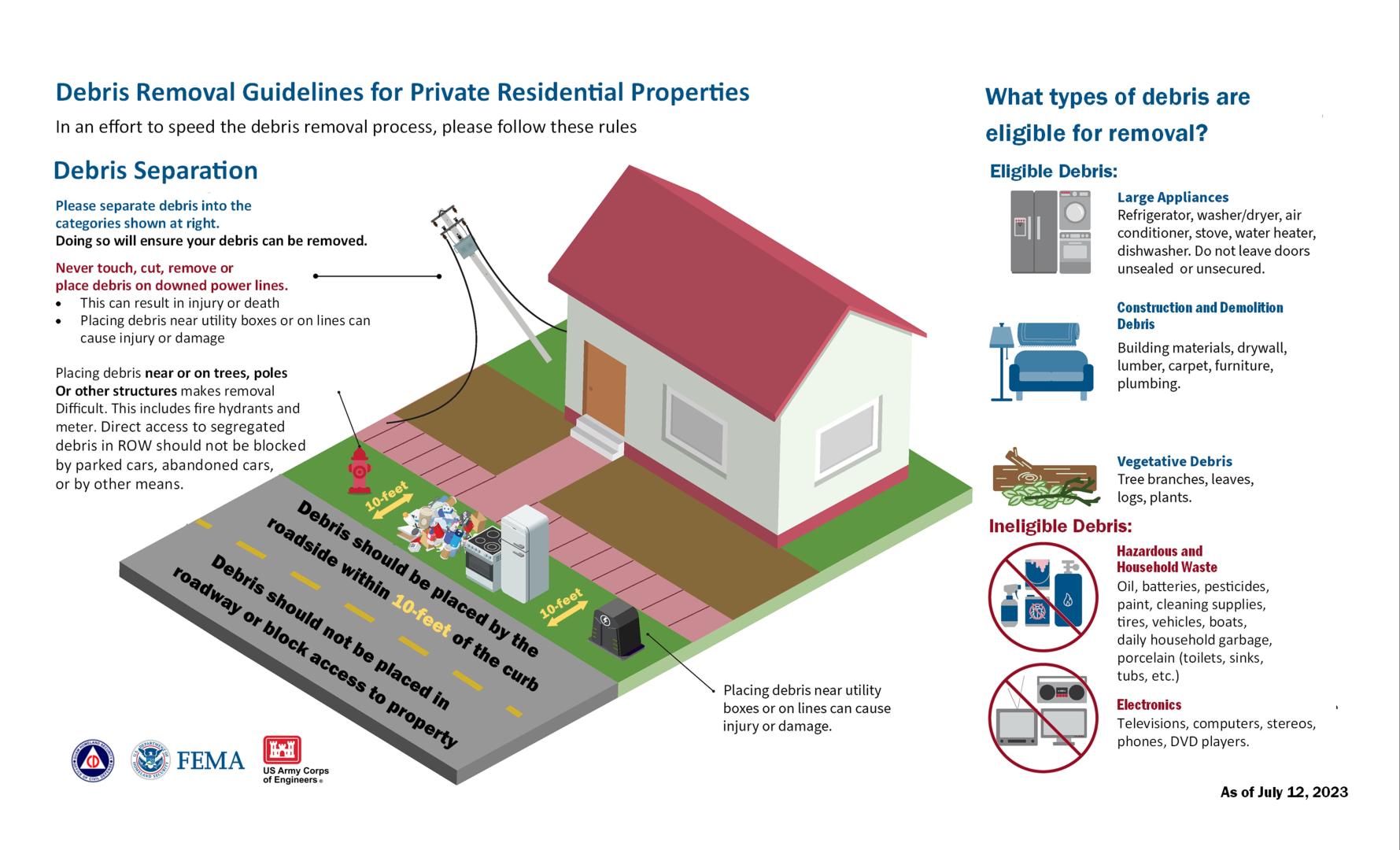After a disaster, the cleanup process will be crucial for a successful recovery. Whether you're a homeowner or a business owner, you should follow the proper guidelines for safe and effective debris removal.
FEMA provides reimbursement to state, local, Tribal Nation and territorial governments for costs related to debris removal through the Public Assistance program. If you are a homeowner, you are responsible for removing debris from your property while following local guidelines and rules. Home insurance settlements can help with removing debris, and there are often volunteer organizations and private companies that offer help, sometimes for free.
Local or state governments usually dispose of disaster-related debris that private property owners place at the curb for pickup on a scheduled date. While we can share general debris clean up guidelines below, local guidance may vary. Please check with your county or municipality to get specific directions for your location.
Here's what you need to know to ensure a successful cleanup.
1 - Prioritize safety.
Wear protective gear such as long pants, sturdy shoes, goggles, gloves and masks when handling debris. Contact your local emergency manager if you have storm-related debris that poses a threat to public health or safety. Stay off damaged structures to prevent any injuries and watch out for snakes or animals. As you clear debris, look carefully for any visible cables and wait for professionals to handle them.
2 - Check with local officials before placing debris for collection.
Local officials will know where and when pickups will be conducted. Speak to your local emergency managers on who to contact about having hazardous debris removed.
3 - Contact your insurance company early to file a claim.
Before starting the cleanup, document all damaged items with photographs, videos and keep all receipts for the work performed for insurance claims and other assistance programs.
4 - Seek professional help.
You can request assistance from volunteer organizations or companies who can help with cutting fallen trees, drywall, flooring and appliance removal, tarping roofs and mold mitigation. Check the bottom of this blog post for links to organizations currently helping after Helene and Milton.
5 - Be cautious around power lines.
Never touch, cut, remove or place debris on downed power lines. As power is restored, this could cause damage, serious injury, or death. If you need to use a chainsaw during debris removal, take extra precautions to avoid contact with power lines and ensure that bystanders are at a safe distance.
6 - Clean and disinfect everything that got wet.
Follow the five basic steps for flood-damaged structures: air out, move out, tear out, clean out and dry out. Always wash your hands with soap and water after handling items contaminated by floodwater or sewage.
7 - Be aware of hazardous materials and toxic substances.
Call your local fire department to inspect or remove chemicals, propane tanks and other hazardous materials. If you get your drinking water from a private well and your area has experienced flooding, make sure the water is safe before drinking. Seal hazardous debris in plastic bags to prevent them from becoming airborne and never burn debris as it can be toxic.
8 - Know how to separate debris and where to place it.

Never block the roadway with debris. Place debris away from trees, poles or structures, including fire hydrants and meters. You can separate debris into five categories when disposing along the curb:
- Electronics (such as televisions, computers, phones)
- Large appliances (such as refrigerators, washers, dryers, stoves or dishwashers. Be sure to seal or secure the doors so they are not accessible)
- Vegetative debris (such as tree branches, leaves or plants)
- Construction debris (such as drywall, lumber, carpet or furniture)
- Household garbage, discarded food, paper or packaging.
9 - Find an organization that can help.
Here are some resources available in states affected by hurricanes Helene and Milton.
Across all affected areas
- UMCOR: Early Response Teams in all affected states to help with things like debris removal and muck and gut.
- Team Rubicon: Help with debris removal, muck outs, route clearance and chainsaw work.
- Crisis Cleanup: Crisis Cleanup has received 60,000 phone calls for help with debris clean up. More than 1,500 volunteers have answered and returned phone calls. The hotline number will remain the same for both Helene and Milton (844-965-1386).
North Carolina
- Church of Jesus Christ of LDS: Conducting debris removal, as well as muck and gut.
- Reach Global Crisis Response: Conducting tree removal, as well as muck and gut.
Florida
- Starfish Disaster Recovery: This organization is meeting urgent chainsaw needs in Madison County. Capabilities include tarps/roof patch, chainsaw work tree/debris, muck outs, and wellness checks.
- All Hands and Hearts: This organization is in Pasco County doing assessments. They have chainsaw teams activated.
- Church of Scientology: This organization conducted assessments and is now doing general roadside clean up, muck and guts, and delivering water and food.
While we often work alongside many of these organizations, the above is not an endorsement of their mission statements.
As you recover, following these guidelines can ensure a safe and effective cleanup process after a disaster. Remember to prioritize safety, seek professional help when needed and dispose of debris properly to expedite the recovery process. For additional resources and information, visit FEMA.gov.

